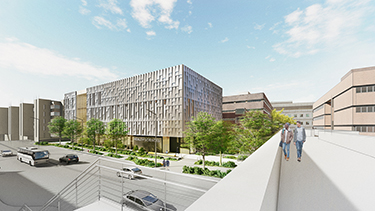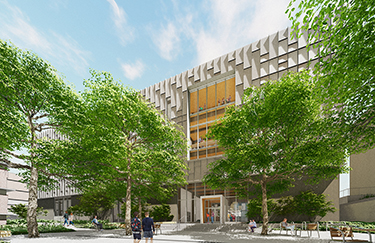|
Subscribe / Renew |
|
|
Contact Us |
|
| ► Subscribe to our Free Weekly Newsletter | |
| home | Welcome, sign in or click here to subscribe. | login |
Construction
| |
 |
February 27, 2020
UW’s new health sciences building will be a hub for 21st-century care
The Miller Hull Partnership
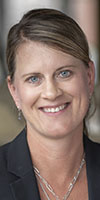
Baleiko
|
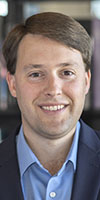
Hellstern
|
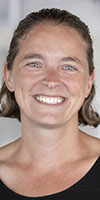
Moggio
|
Following the groundbreaking development of the Hans Rosling Center for Population Health, the University of Washington has embarked on a second new building that will impact thousands of students across the schools of Dentistry, Medicine, Nursing, Pharmacy, Public Health and Social Work.
The Health Sciences Education Building (HSEB) will foster interaction, collaboration and creativity and set a new tone for the existing medical campus. It will be a centrally located hub for the health science schools to train future health professionals in support of affordable, accessible and high-quality, 21st-century health care.
The project is led by our design-build team of Miller Hull, The S/L/A/M Collaborative and Lease Crutcher Lewis.
Improving care culture
To inspire generations of future health care professionals, a culture of care is embedded in all aspects of the HSEB’s design. Our team’s attention to landscape, architectural materials, legibility of wayfinding and visibility of interior activity is intended to set a new example of warmth and invitation to south campus.
The program was carefully crafted to include spaces that spark innovation and creativity with a diversity of environments that encourage collaboration where health science school students learn from each other how to be part of high-performing, healthy delivery teams.
A daylit library, student study and collaboration spaces line the north side of the building facing Northeast Pacific Avenue, while classrooms, skills and anatomy labs are positioned to the south. An interprofessional commons space perches above an outdoor south facing plaza.
By making indoor and outdoor spaces feel more humane, inviting and comfortable, our team hopes that the student experience will feel immersed in those characteristics — and be passed on to future professionals.
High-performing teams
The HSEB project’s commitment to high-performing teams is a driving force in the highly collaborative interdisciplinary design and construction process developed by the design-build team and the UW.
Following on the success of this progressive design-build process in creating the Hans Rosling Center for Population Health, our team embraces a culture of trust and respect as we explore and test solutions that simultaneously consider design, construction, fabrication and sequencing realities. This strategy has enabled our team to work creatively and efficiently, while incorporating extensive owner involvement and long-distance experts, such as S/L/A/M.
Designing a unique HSEB for a world-recognized university on an urban campus provides opportunity to think not just about the successes inside the building, but the potential to impact campus, local and regional success as well.
Stormwater treatment: One of these opportunities comes to our project by way of stormwater treatment.
During site analysis, our team discovered an abandoned concrete flume from the Harris Hydraulics Lab located alongside the basin’s outfall to Portage Bay. Instead of treating only the stormwater from the HSEB, our team designed a regional stormwater treatment facility for the university’s San Juan drainage basin. This system provides greater impact by treating 34 acres of stormwater using a natural process of amended soils and plants.
Working closely with UW, students will be directly involved in studying this stormwater system. A grant provided by the UW Campus Sustainability Fund ensures that students will work to create various soil mediums and test different plant species to find optimal treatment paths.
In addition to the educational benefits, this regional stormwater treatment system will provide a single point for maintenance and operations, greatly reducing the number of stormwater points that both the UW and Seattle Public Utilities must engage with. Predictive models show that this system will significantly increase the amount of treatment that can be provided to this quantity of water and much more quickly than previous long-range plans.
Mass timber: Continuing the theme of larger impact, the UW understands the benefits that building with mass timber can provide for their ever-expanding campus as well as the regional economy.
Utilizing mass timber can bring a significant embodied carbon benefit to the huge global warming footprints associated with new buildings and provide a significantly reduced amount of carbon. Although wood was the material of choice for many buildings several decades ago, it has fallen out of favor for other methods.
To help this resurrection, the UW and the design-build team successfully pursued two federal grants to support the integration of CLT panels as floor and roof structure. One grant provides funding to study the unique vibration characteristics of a mass timber structural system and the impact on building tenants. The other provides support for integrating mass timber in higher education buildings.
Strategic daylighting: With new construction on the UW campus, there is a great opportunity and responsibility to reduce building energy. One of the primary ways to do this is by designing buildings to respond appropriately to their climate.
A newer technology called electrochromic glass can help reduce solar heat gain while maintaining the daylight and visual connection that we all need when inside our buildings. Electrochromic glass uses an electronic signal to tint the glass and block unwanted solar gain. This signal darkens the coating on the glass as lithium ions and electrons transfer from one electrochromic layer to another, allowing for varied levels of tint depending on the voltage used.
Once again partnering with the UW Campus Sustainability Fund, a research proposal that supports the use of electrochromic glass is currently under advisement. If accepted, the goal is to incorporate it into the HSEB so that it can provide targeted areas of electrochromic glass on the south facade, which is most impacted by solar heat gain. Students will then have direct access to the electrochromic system to test the effectiveness and learn its benefits.
Additionally, students from the UW’s Integrated Design Lab will work directly with the design-build team to run various analyses on the use of this glazing and determine the impacts it has to occupants. By using electrochromic glass, this project provides another rewarding way for our team to engage with students and create additional learning opportunities on their own campus.
Ruth Baleiko is a partner at the Miller Hull Partnership, Chris Hellstern is the Living Building Challenge services director, and Elizabeth Moggio is a senior associate.
Other Stories:
- Hospital projects in rural areas face extra obstacles
- Good design takes some stress out of visiting the hospital
- Building out this new hybrid OR was no simple operation
- Hospitals giving way to other care options as providers look to cut costs
- CHP systems: a powerful energy-saving tool for hospitals
- A look inside the Cure Factory, Seattle Children’s new cell therapy lab
- Fire dampers: one more way hospitals can save lives
- Integrated project delivery offers risks and rewards for team members
- Health care could look a lot different in 2040, so get ready
- Here’s what’s in store for health care in the Northwest
- How welcoming design can improve outcomes for patients — and staff



